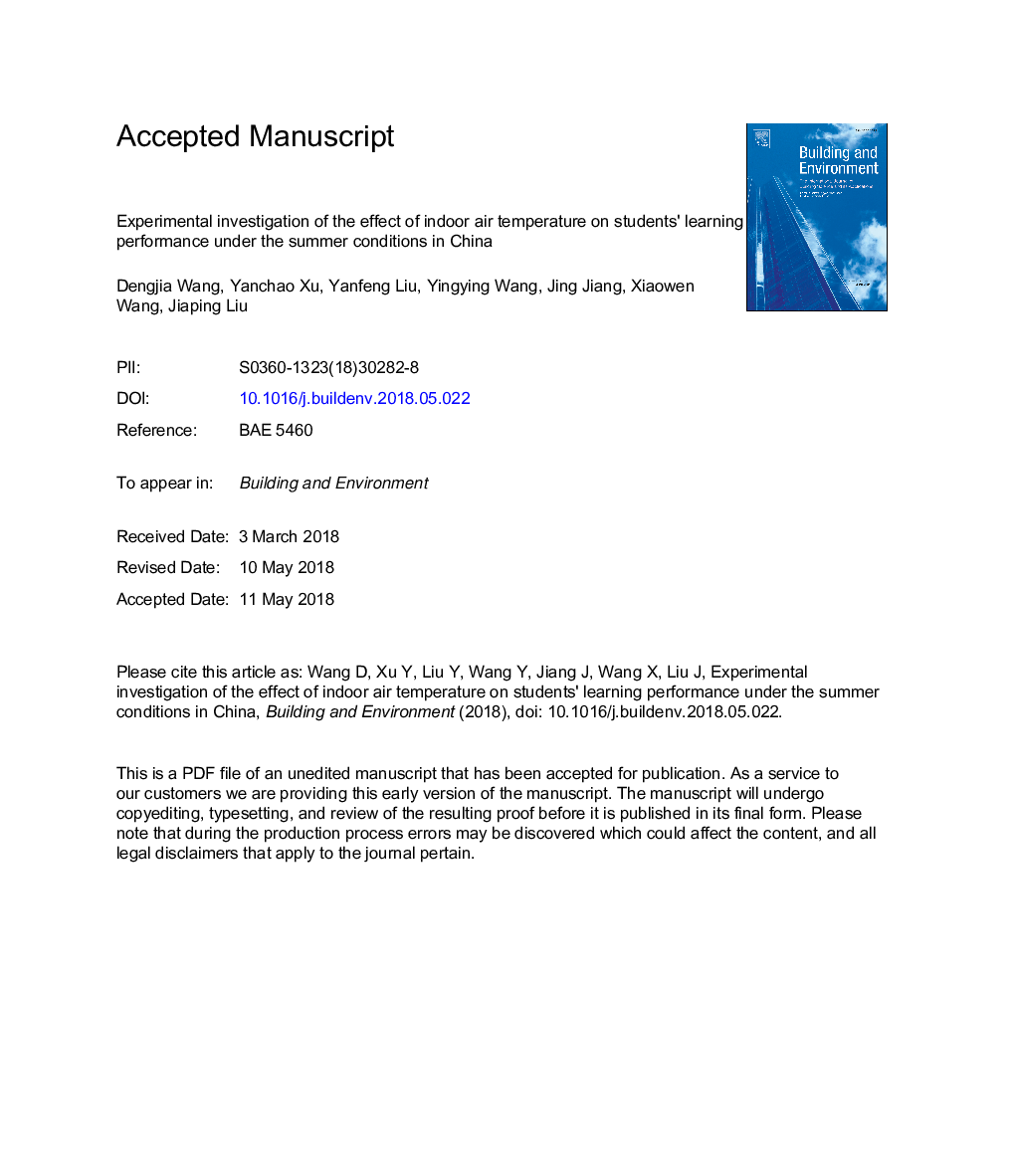| کد مقاله | کد نشریه | سال انتشار | مقاله انگلیسی | نسخه تمام متن |
|---|---|---|---|---|
| 6696997 | 1428352 | 2018 | 51 صفحه PDF | دانلود رایگان |
عنوان انگلیسی مقاله ISI
Experimental investigation of the effect of indoor air temperature on students' learning performance under the summer conditions in China
ترجمه فارسی عنوان
بررسی تجربی اثر دمای هوای داخل ساختمان بر عملکرد یادگیری دانش آموزان در شرایط تابستانی در چین
دانلود مقاله + سفارش ترجمه
دانلود مقاله ISI انگلیسی
رایگان برای ایرانیان
کلمات کلیدی
دمای هوا داخل محفظه، عملکرد آموزشی، دانشجو، ادراک حرارتی،
ترجمه چکیده
محیط حرارتی یک کلاس درس تأثیر قابل توجهی بر عملکرد یادگیری و ادراک حرارتی دانش آموزان دارد. در این تحقیق، محیط محیطی کنترل شده برای مطالعه اثر محیط محیط محیطی بر عملکرد یادگیری دانش آموزان در تابستان ایجاد شد. نکته اصلی این تحقیق این بود که بررسی تاثیر دمای هوای داخل ساختمان بر ادراک حرارتی و عملکرد یادگیری دانش آموزان است. برای این مطالعه، دانشجویان برای شرکت در آزمایش ها تحت شرایط مختلف دمای هوا استخدام شدند. یک پرسشنامه ارزیابی ذهنی که حاوی آراء احساس گرما، رای دادن های رضایت حرارتی و سایر ارزیابی های رضایت از کیفیت محیط زیست بود، برای اطمینان از راحتی حرارتی شرکت کنندگان و ارزیابی کیفیت محیط داخلی محاسبه شد. علاوه بر این، عملکرد یادگیری مشارکت کننده به صورت کمی از طریق وظایف شامل درک، توجه، حافظه یادگیری، و تفکر مورد آزمایش قرار گرفت. در همان زمان، دمای بدن، فشار خون و ضربان قلب شرکت کنندگان قبل و بعد از آزمون های عملکرد یادگیری اندازه گیری شد. تمام نتایج آزمون های فوق مورد تجزیه و تحلیل قرار گرفت و روابط بین راحتی حرارتی، عملکرد یادگیری و محیط حرارتی بدست آمد. نتایج نشان داد که در محدوده دمای آزمایشگاهی، عملکرد بهینه در زمانی که شرکت کننده احساس می کرد گرمی داشته باشد، به دست آمد. محیطی از ناراحتی های سرد به عملکرد یادگیری مضر تر از یک محیط ناراحتی گرم بود. به عنوان افزایش رضایت حرارتی افزایش یافته است، عملکرد یادگیری بهبود یافته است. در نهایت، نتیجه گیری این آزمایش برخی از داده ها پشتیبانی از طراحی محیط محیط حرارتی کلاس های درس مورد استفاده در تابستان است.
موضوعات مرتبط
مهندسی و علوم پایه
مهندسی انرژی
انرژی های تجدید پذیر، توسعه پایدار و محیط زیست
چکیده انگلیسی
The thermal environment of a classroom has a crucial impact on the learning performance and thermal perceptions of students. In this research, a controlled environment was established to study the effect of indoor environment on students' learning performance in summer. The keystone of this research was to study the effect of indoor air temperature on students' thermal perception and learning performance. For this study, students were recruited to participate in the experiments under various air temperature conditions. A subjective evaluation questionnaire that contained thermal sensation votes, thermal satisfaction votes, and other environmental quality satisfaction votes was distributed to ascertain the thermal comfort of the participants and gather their evaluations of the indoor environment quality. In addition, participant learning performance was quantitatively tested via tasks, involving perception, attention, learning-memory, and thinking. At the same time, the body temperature, blood pressure, and heart rate of participants were measured before and after the learning performance tests. All of the above test results were analyzed, and the relationships among thermal comfort, learning performance, and thermal environment were obtained. The results showed that within the experimental temperature range, optimal performance was obtained when participants felt “slightly warm.” An environment of cold discomfort was more harmful to learning performance than an environment of warm discomfort. As thermal satisfaction votes increased, learning performance improved. Finally, the conclusions of this experiment provide some data support for the thermal environment design of classrooms used during the summer.
ناشر
Database: Elsevier - ScienceDirect (ساینس دایرکت)
Journal: Building and Environment - Volume 140, August 2018, Pages 140-152
Journal: Building and Environment - Volume 140, August 2018, Pages 140-152
نویسندگان
Dengjia Wang, Yanchao Xu, Yanfeng Liu, Yingying Wang, Jing Jiang, Xiaowen Wang, Jiaping Liu,
